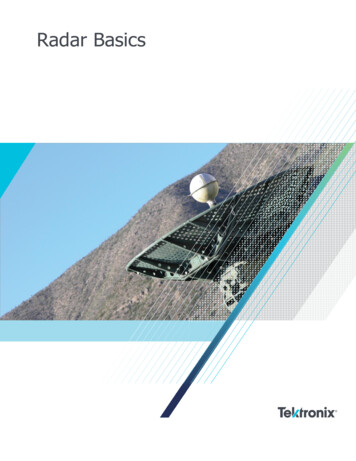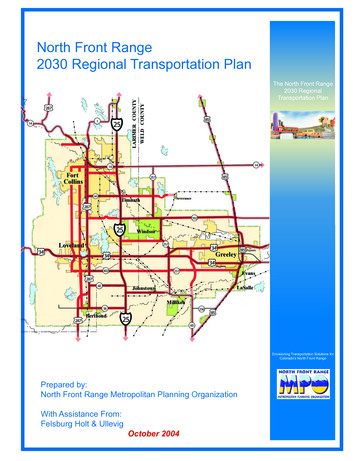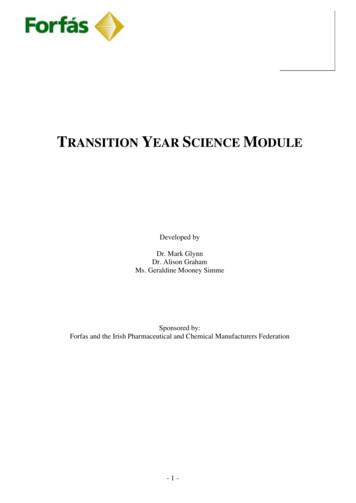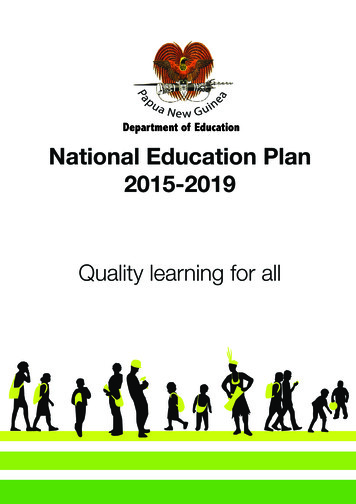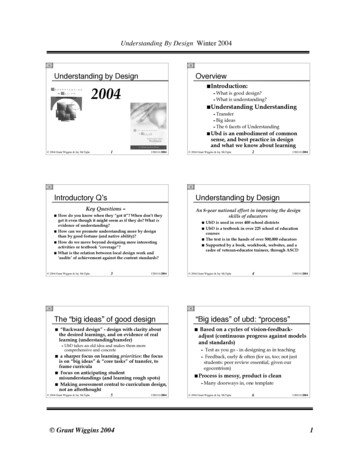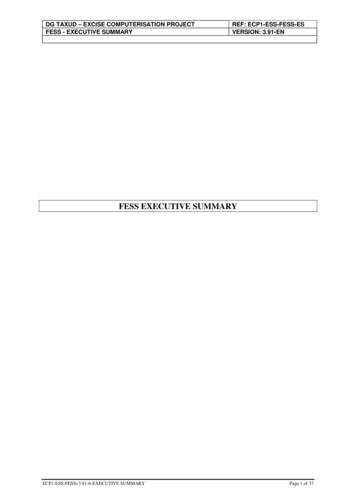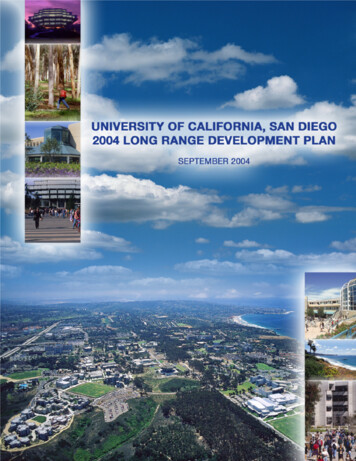
Transcription
UNIVERSITY ofCALIFORN IA,SAN DIEGO2004 LONG RANGEDEVELOPMENTPLAN
LONG RANGE DEVELOPMENT PLAN 2004Table ofContentsExecutive Summary . . . . . . . . . . . . . . . . . . . . . . . . . . . . . . . . . . . . . . 1Chapter 1 Introduction . . . . . . . . . . . . . . . . . . . . . . . . . . . . . . . . . . 3A.B.C.D.E.F.Scope. . . . . . . . . . . . . . . . . . . . . . . . . . . . . . . . . . . . . . . . . . 4Academic Context. . . . . . . . . . . . . . . . . . . . . . . . . . . . . . . . 5Enrollment Parameters . . . . . . . . . . . . . . . . . . . . . . . . . . . . 6Campus History and Community Relationship . . . . . . . . . 6UCSD Long Range Development Plans . . . . . . . . . . . . . . 10Process . . . . . . . . . . . . . . . . . . . . . . . . . . . . . . . . . . . . . . . 12Chapter 2 Planning Context . . . . . . . . . . . . . . . . . . . . . . . . . . . . . 13A.B.C.D.E.F.G.Existing Enrollment and Campus Population . . . . . . . . . .Academic Program . . . . . . . . . . . . . . . . . . . . . . . . . . . . . .Ancillary Programs . . . . . . . . . . . . . . . . . . . . . . . . . . . . . .Property Locations . . . . . . . . . . . . . . . . . . . . . . . . . . . . . .Grounds and Buildings . . . . . . . . . . . . . . . . . . . . . . . . . . .Environmental Setting . . . . . . . . . . . . . . . . . . . . . . . . . . .Physical Constraints . . . . . . . . . . . . . . . . . . . . . . . . . . . . .13142427313637Chapter 3 The 2004 Long Range Development Plan . . . . . . . . . 39A.B.C.D.TA B L E O F C O N T E N T SProjected Enrollment and Campus Population . . . . . . . . .Program Development . . . . . . . . . . . . . . . . . . . . . . . . . . .Planning Principles . . . . . . . . . . . . . . . . . . . . . . . . . . . . . .Land Use Plan . . . . . . . . . . . . . . . . . . . . . . . . . . . . . . . . . .39414551i
LONG RANGE DEVELOPMENT PLAN 2004LIST OF TABLES, FIGURES & APPENDICESTables1234567891011Regular Academic Year Headcount Enrollment1989-90 & 2002-03 and Projected 2005-06 . . . . . . . . . . . . . 14Regular Academic Year Campus Population1989-90 & 2002-03 and Projected 2005-06 . . . . . . . . . . . . . 14Property Acquisitions . . . . . . . . . . . . . . . . . . . . . . . . . . . . . . 28Acreage by Area and Development Status . . . . . . . . . . . . . . 32Development Gross Square Feet by Location / Function1989-90 & 2002-03 and Projected 2005-06 . . . . . . . . . . . . . 32FTE Enrollment2002-03, Projected 2020-21 . . . . . . . . . . . . . . . . . . . . . . . . . 40Headcount Enrollment2002-03, Projected 2020-21 . . . . . . . . . . . . . . . . . . . . . . . . . 40Campus Population: Regular Academic Year2002-03, Projected 2020-21 . . . . . . . . . . . . . . . . . . . . . . . . . 41Campus Population: Summer Session2002-03, Projected 2020-21 . . . . . . . . . . . . . . . . . . . . . . . . . 41Development Gross Square Feet2002-03, Projected 2020-21 . . . . . . . . . . . . . . . . . . . . . . . . . 42Parking Space Capacity2002-03, Projected 2020-21 . . . . . . . . . . . . . . . . . . . . . . . . . 44Figures1234567891011Regional Location Map . . . . . . . . . . . . . . . . . . . . . . . . . . . . . 3Campus Map . . . . . . . . . . . . . . . . . . . . . . . . . . . . . . . . . . . . . 4City of San Diego Community Plan Areas . . . . . . . . . . . . . . 81989 LRDP Land Use Plan . . . . . . . . . . . . . . . . . . . . . . . . . . 11UCSD Facilities, 2003-04 . . . . . . . . . . . . . . . . . . . . . . . . . . . 31Vehicular Circulation Concept . . . . . . . . . . . . . . . . . . . . . . . 33Pedestrian Circulation Concept . . . . . . . . . . . . . . . . . . . . . . 43Neighborhood Concept . . . . . . . . . . . . . . . . . . . . . . . . . . . . 46Academic Corridors Concept . . . . . . . . . . . . . . . . . . . . . . . . 48Park Concept . . . . . . . . . . . . . . . . . . . . . . . . . . . . . . . . . . . . 492004 LRDP Land Use Plan (color) . . . . . . . . . . . . . . . . . . . 53AppendicesABiiExisting Buildings by Location and Year Occupied. . . . . . . 552004 LRDP Land Use Plan (black & white) . . . . . . . . . . . . 67TA B L E O F C O N T E N T S
EXECUTIVESUMMARY
LONG RANGE DEVELOPMENT PLAN 2004EXECUTIVESUMMARYThe 2004 Long Range Development Plan (LRDP) for the University of California,San Diego (UCSD) provides a general land use plan to guide the physical development of the campus. Based upon academic and student life goals, the LRDPidentifies development objectives, delineates campus land uses, and estimates thenew building space needed to support program expansion through the planninghorizon year of 2020-21. This LRDP updates the previous plan, adopted by TheRegents of the University of California (The Regents) in 1989, which projected aneed for approximately 15.9 million gross square feet (GSF) of development (orabout 9.9 million assignable square feet) by the 2005-06 academic year.The Master Plan for Higher Education in California directs the University ofCalifornia (UC) to provide instruction in the liberal arts and sciences. UC alsois assigned exclusive responsibility for doctoral and professional education inmost disciplines and is designated as the primary state-supported academicagency for research. Given a projected increase in the number of high schoolgraduates and in accordance with the California Master Plan for Higher Education, which guarantees access to UC for the top 12.5% of California’s publichigh school graduates and qualified transfer students from California Community Colleges, all the UC campuses are now planning to increase enrollmentsto meet anticipated demand.Consequently, the UCSD plan accommodates a regular academic year (i.e., theFall, Winter, and Spring quarters) headcount enrollment of 29,900 by 2020-21,the end of the term covered by this revision of the LRDP the headcount enrollment is equivalent to 29,100 full-time equivalent (FTE) students. In addition,UCSD projects a summer session enrollment of about 3,600 FTE by 2020-21.Because these enrollment targets and the associated projected space need of 19.2million GSF are greater than the projections presented in the 1989 LRDP, UCSDhas undertaken the 2004 LRDP and prepared a new Environmental Impact Report(EIR) in compliance with Section 21080.09 of the California Environmental Quality Act (CEQA).The 2004 LRDP has the following characteristics: This document is the fifth comprehensive LRDP for UCSD; previous planswere produced in 1963, 1966, 1981, and 1989. Like its predecessors, this plan encompasses the UCSD properties in the University Community and La Jolla Shores areas of the City of San Diego. In accordance with the CEQA, an EIR that addresses the environmental implications of the plan set forth herein is presented in a separate document. Academic plans for a large, comprehensive research university composedof small undergraduate colleges have provided the basis for determining theoptimum size and physical needs of the campus.E X E C U T I V E S U M M A RYPage 1
LONG RANGE DEVELOPMENT PLAN 2004 In the course of producing the 2004 LRDP the campus considered nine factors,including:- Academic and non-academic program requirements;- Distribution of student enrollment across the academic programs;- Optimum rate of student and faculty growth;- Appropriate ratio of graduate students to undergraduate students;- UCSD’s unique characteristics in light of its history and culture;- Environmental resources;- Need for services such as student housing, parking, transportation, recreation, childcare, and administrative support;- Opinions of various campus constituencies and community stakeholders;and- The needs and interests of the surrounding community,city, state, and nation. The 2004 LRDP identifies 297 acres of undeveloped land,enough to accommodate the facilities needed for realizing thecampus’ program goals. The 2004 LRDP describes the long term planned intensityof the campus. Consistent with the 1989 LRDP, the 2004LRDP incorporates five general concepts, derived from acomprehensive analysis called the UCSD Master Plan Study(1989), to guide physical planning processes during the termof this LRDP:- Neighborhoods are compact clusters of buildings and open space used tobreak the campus into smaller communities that have distinct boundariesand coherent urban design.- The University Center is a neighborhood intended to serve as the “downtown” of the campus, a center of academic, social, and administrativeactivities.- Academic Corridors comprise a conceptual planning principle to bringrelated departments into proximity and to provide a consistent basis forlocating academic facilities in the future.- The Park encompasses the campus’ natural resources, such as the coastalbluffs, hillsides, canyons, and eucalyptus groves.- Connections are the courtyards, arcades, paths, roads, public entries,landmarks, view corridors, landscape features, and building forms that tiethe campus together and to the community while preserving the smallerscale and distinctive attributes of the neighborhoods.Page 2E X E C U T I V E S U M M A RY
Chapter 1INTRODUCTION
LONG RANGE DEVELOPMENT PLAN 2004Chapter 1INTRODUCTIONThe Regents of the University of California approved the first Long Range Development Plan (LRDP) for UCSD in 1963 with subsequent revisions occurring in1966, 1981, and 1989. This LRDP is the fifth such plan for UCSD. Like itspredecessors, the 2004 UCSD LRDP encompasses only the UCSD main campusproperties located in La Jolla (Figure 1). The University has set academic year2020-21 as the planning horizon for this revision of the LRDP, fifteen years beyondthe 2005-06 planning horizon of the campus’ 1989 LRDP. In accordance with theCEQA, UCSD prepared an EIR that addresses the environmental implications ofthe 2004 LRDP as a separate document. The organization of the 2004 LRDP is asfollows:Executive SummaryScripps RanchMainCampusTradeStreet805Chapter 1 : Introduction Introduces the concept and limits ofthe plan; Discusses aspects of UCSD’s history,organization, relationship to the community, and previous LRDPs that arerelevant to a full understanding ofthis document; and Briefly describes the 2004 LRDPprocess.ElliottField Station52Mt. ampusOceanBeachNimitzMarineFacilityCoronado2 MilesAreas of UCSD includedin LRDPOutlying propertiesexcludedfrom LRDPPointLoma0 Miles94DowntownSan Diego4 MilesRegional Location MapFigure 1Chapter 1 - INTRODUCTIONChapter 2 : The Planning Context Sets forth enrollment projections,academic plans, and ancillary programs that provide the basis for thephysical plan; Enumerates all properties under thepurview of UCSD; and Describes the existing facilities, landuses, and environmental setting ofthe campus (Figure 2, page 4).Chapter 3 : The 2004 LRDP Presents estimates of the enrollments,faculty, staff, space, and parkingneeded to fulfill the campus’s academic and ancillary program objectives; Describes the five broad planningconcepts derived from the UCSDMaster Plan Study; and Updates UCSD’s general land use,transportation, circulation, and parking plans.Page 3
LONG RANGE DEVELOPMENT PLAN 2004A. SCOPEThe University of California (UC) requires that each campus and medical centermaintain an LRDP, a general land use plan, to guide capital project developmentand approval. The process of periodically updating an LRDP provides TheRegents an opportunity to make certain that physical plans remain solidly basedon academic program goals. This document’s purpose, therefore, is to provide abroad, coherent, and adaptable policy framework to achieve UCSD’s academicand support program goals and to inform decisions concerning land use.TORREYPINES CTR.Genesee AGLIDERPORTTorreyLEGEND5ve.California CoastalZone BoundaryPinesScenicProperty LineDr.U.C. PropertySalkInstitute Rd.WESTCAMPUSExcluded from LRDPGeeen esAve.a Farmso e Dr.a Jolla Dr.Villa LNobel Dr.Lebon Dr.Gilman Dr.nicSceLa JollaTorreyPinesRd.Dr.La JollaSIOEastgateMallRegents Rd.SCRIPPSCOASTALRESERVELaSho Jollares Dr.PACIFICOCEANRdUNIV. HSE.BEACH PROP.N. Torrey Pines Rd.PointDr.Voigt Dr.CampusBLACKHORSEPROP.LA JOLLADEL SOL50FT400FT800FT1600FTCampus MapFigure 2The 2004 LRDP is intended to: Bring UCSD’s long range land use planning up to date in light of currentlyforeseen changes in the demographic and educational landscape; Equip the campus with a broad, coherent, and adaptable policy framework toachieve UCSD’s program goals; and Provide a basis for future decisions concerning land uses and capital projects.Page 4Chapter 1 - INTRODUCTION
LONG RANGE DEVELOPMENT PLAN 2004This LRDP is not intended to: Prescribe a detailed blueprint for how to carry out the plan; or Commit either the campus or the University of California (UC) to specificprojects, construction schedules, or funding priorities.The University is concerned about the impact of future campus developmenton the surrounding community. Accordingly, and in compliance with theCalifornia Environmental Quality Act (CEQA), the University describes anddiscusses the environmental consequences it foresees of implementing the2004 LRDP in an associated EIR, presented as a separate document. Wherever possible, the EIR presents ways to mitigate or eliminate potential adverseeffects arising from implementation of this LRDP, and explores reasonablealternatives to the plan.To assure the full assessment and review of environmental impacts resultingfrom development at UCSD, the campus is committed to ongoing, carefulappraisal of such effects through a physical planning process. In addition,major construction proposals are reviewed and approved by the Chancellor,the Office of the President, and, where appropriate, The Regents in accordancewith University policies and in compliance with the provisions of the California Environmental Quality Act.B. ACADEMIC CONTEXTFounded in 1960, UCSD is one of ten campuses in the University of California(UC) system. The goals for the campus are to educate the next generation ofleaders and to enhance the intellectual, scientific, and technological resources ofSan Diego, California, and the nation at large. In its brief history the campus hasbecome one of the most prominent research universities in the country, with adistinguished faculty and student body. UCSD’s academic quality is reflected ina range of national rankings; e.g., the number of faculty elected to the NationalAcademy of Sciences, the National Research Council’s ratings of the overall qualityof its faculty and graduate programs, and the amount of federally funded researchawards. In addition, the quality of UCSD’s instructional programs is reflected bythe fact that it consistently receives more than 40,000 applications from prospectiveundergraduates. With annual revenues in FY 2003 exceeding 1.8 billion, UCSDis the third largest employer in San Diego, and more than 200 local companies cantrace their roots to UCSD.In 2002-03 there were about 22,550 regular academic year student (excludingSummer) full-time equivalent (FTE) students and nearly 2,600 faculty and academic research staff at UCSD. In order to meet the increasing enrollment demandsso that the UC system may fulfill its obligations to the citizens of California, thecampus projects enrollments to increase by approximately 30% and the number offaculty will increase commensurately. Accordingly, a substantial capital improvement program will be required. The University will accommodate this growthduring the next decade without compromising the quality of its faculty, teaching,and research programs. The campus is committed to recruit and retain an ethnicallydiverse faculty and student body and to develop programs to encourage students topursue graduate and professional training. UCSD’s unique undergraduate collegesystem, which provides undergraduates with an intellectual and social environment, independent of their major academic department, will be preserved.Chapter 1 - INTRODUCTIONPage 5
LONG RANGE DEVELOPMENT PLAN 2004The planning for campus growth reflects a process of shared governance betweenthe faculty and the administration. Academic planning begins with the faculty inthe academic units and ends in consultation between the administration and therepresentative leadership of the San Diego Division of the Academic Senate.C. ENROLLMENT PARAMETERSA key factor that prompted this update of the LRDP is the prospect of increasesin enrollment in all segments of California higher education. In 1998, theCalifornia Department of Finance projected that enrollments in California’spublic institutions of higher education will rise by about 714,600 students by2010. More recent projections by the state’s Department of Finance corroborate these projections of substantial growth in all segments of California highereducation. Demographers attribute this enrollment growth both to an increasein the absolute size of the college-age population and to anticipated increasesin overall college eligibility and participation rates.In 1963, UCSD completed its first academic plan and concluded that to accomplishits objectives it would ultimately grow to 27,500 regular academic year students.In comparison, the present academic plan projects a total enrollment of 29,900 students during the 2020-21 regular year academic (i.e., the Fall, Winter, and Springquarters). To enhance the efficient use of campus facilities and provide studentswith more opportunities to advance academically, the campus also plans to increaseenrollment during the summer. UCSD will accommodate approximately 3,600FTE students with an projected headcount of 18,600, primarily undergraduates,in expanded summer programs on the General campus in accord with agreementsbetween the UC and the State.D. CAMPUS HISTORY AND COMMUNITY RELATIONSCalifornia established its first public university in 1868 in response to theFederal Morrill Land Grant Act of 1862. The State set UC apart within itsConstitution as a separate entity and by doing so conferred on UC a degreeof autonomy that remains rare for a public institution of higher education. Atthe time of its establishment, the primary mission of UC was to disseminatepractical knowledge and skills. As the State grew, and technology and scholarship advanced, expanding the boundaries of human knowledge and skillsthrough basic and applied research became an integral part of that mission ofeducation.An understanding of the campus’s unique history and culture is important in understanding its mission, physical development, priorities, and plans for the future.This section provides a brief history of the establishment of UCSD from its beginning as a marine research laboratory in the early 1900’s.UCSD is the direct descendant of the renowned Scripps Institution of Oceanography. In 1903, zoologists from the University of California, Berkeley established amarine research laboratory in a boathouse of the Hotel Del Coronado on GloriettaBay. The laboratory was soon moved to a facility at La Jolla Cove and, severalyears later, relocated again, to its present location on a large tract of land in the LaJolla Shores neighborhood.Page 6Chapter 1 - INTRODUCTION
LONG RANGE DEVELOPMENT PLAN 2004The marine science research station became part of UC in 1912 and in 1913, tohonor the support of Ellen B. and Edward W. Scripps, was named the ScrippsInstitute of Biological Research. Finally, in 1925, UC renamed it the ScrippsInstitution of Oceanography (SIO) and it went on to establish itself as perhapsthe world’s foremost institution focusing on basic research in the oceans, globalgeophysics, and atmospheric systems.In the early 1950’s, local leaders in government, business, and education beganefforts to establish a research university in San Diego. In 1953, the statewideStudy of the Need for Additional Centers of Higher Education in Californiaidentified the San Diego region as a prime candidate for a university. In 1955,the San Diego City Council formally committed the City to aiding “in everyway” the development of such an institution.The successful orbit of the Soviet Union’s Sputnik in 1957 stimulated widespread national and local support for education, especially for expanding thesupply of scientists and engineers. That same year, The Regents commissioneda study of potential sites for a new campus in the San Diego region. The studynarrowed the list of potential sites from twenty-three to three: Balboa Park,Lake Murray, and La Jolla.In 1958, following extensive discussion, The Regents authorized planning for a“large campus” of the University in the La Jolla area adjacent to SIO. In response,the San Diego City Planning Commission passed, and the City Council endorsed,the following resolution:“Whereas the Board of Regents of the University of California has indicatedan interest in locating a large branch of the University of California at LaJolla, and whereas it is in the best interest of the citizens of San Diego toencourage and assist in the establishment of such a University in the SanDiego area, NOW BE IT RESOLVED that the City of San Diego will proceedto prepare a new Master Plan of the areas adjacent to the proposed La Jollasite of the University of California, including a compatible land use plan anda local highway system to adequately serve the proposed University and itsenvirons.“Be IT FURTHER RESOLVED that the City of San Diego offers its fullest cooperation to coordinate its planning, zoning and development programs in the vicinity toprovide essential services and to provide the desirable community and atmosphereconducive to the University of California at La Jolla, and to this end will consultand cooperate with any representative of the Board of Regents appointed for planning purposes in the development of the University.”That UC chose to establish a comprehensive campus in San Diego is due in nosmall part to the involvement, enthusiasm, and commitment of the community.Accordingly, UCSD has striven to maintain a positive, productive, and responsiverelationship with area residents, officials, and agencies by actively interacting withthe community and taking their needs and concerns into account in campus plans,activities, and development.Chapter 1 - INTRODUCTIONPage 7
LONG RANGE DEVELOPMENT PLAN 20041. University Community PlanThe 1959 University Community Study, produced by the City of San Diego inconjunction with the University, envisaged a comprehensive research universityenrolling about 25,000 students after the turn of the century. The Study assumedthe campus would occupy approximately 1,000 acres of land and recommended thedevelopment of “neighborhoods” in the university area, “influenced by topographyand other natural features” and “created by a thoughtful placement and groupingof facilities.”. Moreover, the plan envisioned a University city or “City of theMind” and stated that “a truly University oriented city, with the natural advantagesof climate and site here present, can provide compelling attractions to teachersand students alike.” To help integrate the campus and surrounding community, itrecommended the development of a relatively urbanized and commercial “towncenter” on the southwest corner of the UCSD site.The City amended the University Community Plan(formerly Study) in 1961,1963, 1965, 1971, and1987. These amendmentsacknowledged and soughtto manage the increasinglyurban character of the area.The latest version of thiscommunity plan retainsthe goal of encouraging thedevelopment of “housingfor students and employeesof the University” andUCSD remains a vigorous advocate of this goal.Nevertheless, because thedemand for housing surrounding the Universityby both University andnon-University affiliates isincreasingly strong, UCSDhas had to ascribe moreimportance than originallyplanned to providing housing, as well as other servicesand amenities, on campus.Figure 3 depicts the areacovered by the UniversityCommunity Plan.Del MarLEGEND5UCSDUniversity Community PlanLa Jolla Community PlanLa Jolla ShoresPrecise Plan805PACIFIC15UCSDOCEANSIO52La Jolla163Pacific Beach5NTSCity of San Diego Community Plan AreasFigure 3The University community has become a major employment and residentialarea within the City of San Diego. Much of the commercial, scientific research,and residential development programmed in the community plan has occurred.Sustaining an effective partnership between the campus and the community inaddressing issues such as housing, traffic congestion, and mass transit is extremelyimportant.Page 8Chapter 1 - INTRODUCTION
LONG RANGE DEVELOPMENT PLAN 20042. La Jolla Community and La Jolla Shores Precise PlansBy the mid-1960’s, community planning efforts reflected a greater concern forgrowth management. In 1967, the City Council adopted the La Jolla CommunityPlan as a general master plan to accommodate and guide “community growth bothin terms of size and location.”. The La Jolla Community Plan in turn recommended the development of more detailed plans for sub-areas. The La Jolla ShoresPrecise Plan adopted in 1972, and first implemented by a Planned District Ordinancein 1974, was the outcome of this recommendation.The adoption of the California Coastal Act of 1976 and the creation of the California Coastal Commission, La Jolla Community Plan and La Jolla Shores PrecisePlan provided valuable building blocks for the development of the Local CoastalProgram. UCSD’s local coastal program permitting is discussed in Chapter 2Section G.2. on page 37. The La Jolla Community Plan was updated in 1976and 2002. In general, the plans seek to preserve the predominantly single-familyresidential character of the La Jolla area.3. Impact on the San Diego AreaThe great hope, enthusiasm and support that accompaniedUCSD’s founding in 1960 has remained strong over time.In addition to UCSD’s contributions to San Diego’s highlytrained workforce, the campus has had a profound impact onthe regional economy. In FY 2003, UCSD’s annual revenueswere 1.8 billion (26% was from the federal government, 25%of this total was from medical revenues, 19% was from theState of California, 7% was from private donations, and 23%was from a variety of sources such as auxiliary enterprises,tuition and fees, educational activities, etc.). Thus, for everydollar the State of California invests in UCSD, the universitygenerates four more, and reinvests them largely in the regionaleconomy.As one of San Diego County’s largest employers, in 2002, UCSD’s monthly payroll exceeded 71 million. In addition, UCSD annually purchases approximately 600 million in goods and services. UCSD faculty, staff, students and alumnihave spun-off over 200 local companies. Even with the benefits stemming fromthe University expansion and cooperation, the wise management of growth willcontinue to pose a complex and difficult challenge for the University and thegreater San Diego area. However, as UCSD strives to fulfill its publicly mandatedacademic mission during a period of continuous growth, it will remain committedto maintaining and enhancing its working relationship with the community anddeveloping creative solutions.Chapter 1 - INTRODUCTIONPage 9
LONG RANGE DEVELOPMENT PLAN 2004E. UCSD LONG RANGE DEVELOPMENT PLANSUCSD has produced five LRDPs including the 2004 LRDP. This section of theIntroduction briefly summarizes the similarities and differences among the LRDPsand concludes with a short description of the process for developing the 2004LRDP.1. The 1963 LRDPFrom the outset, as set forth in UCSD’s original Academic Master Plan(1963), campus leaders envisioned building the kind of comprehensive andoutstanding instructional and research programs that would require a campusof substantial size, and therefore planned for a campus enrolling 27,500 students at steady-state. The Academic Master Plan also sought to develop asmall number of comprehensive departments rather than a plethora of highlyspecialized programs complemented by the vigorous development of interdisciplinary programs. Furthermore, the administration was decentralized, withthe departments each reporting directly to the Vice Chancellor - AcademicAffairs through their chairs.The 1963 academic plan also described a system of autonomous liberal arts colleges operating within the context of the research university. Planners envisioneda college system that would provide all students, undergraduate and graduate alike,a choice of educational environment, where each college would offer the intimacyof a small to medium-sized college, the leadership of a Provost, a distinctive andcomprehensive curriculum, and ready access to the resources of a large university.Reflecting the academic plan, the 1963 LRDP identified sites for twelve such colleges.2. The 1966 LRDPThe 1966 LRDP was based on the 1963 plan and made the same assumptionsregarding enrollment and total campus population. It also called for twelve collegesgrouped into small-college clusters. In addition, the 1966 LRDP sited the CentralLibrary (now called the Geisel Library) and identified the Veterans AdministrationMedical Center as an area outside the Campus.3. 1981 LRDPDemographic forecasts produced during this era projected a decline in the numberof high school graduates and therefore a drop in the enrollment potential for theentire University of California through the mid-1990’s. Consequently, it appearedlikely that UCSD would grow into a comprehensive educational institution moreslowly than originally expected. In response, the 1981 LRDP planned for an enrollment of 14,700 students by the mid-1990’s and adjusted plans for the physicalexpansion of the campus. The campus sustained its vision of stimulating academicexcellence, extending the scope of its instructional and research programs, anddeveloping the college system.Given revised demographic projections and the reduced capital funding duringthe era of the Vietnam War, less dense
opment Plan (LRDP) for UCSD in 1963 with subsequent revisions occurring in 1966, 1981, and 1989. This LRDP is the fifth such plan for UCSD. Like its predecessors, the 2004 UCSD LRDP encompasses only the UCSD main campus properties located in La Jolla (Figure 1). The University has set academic year

